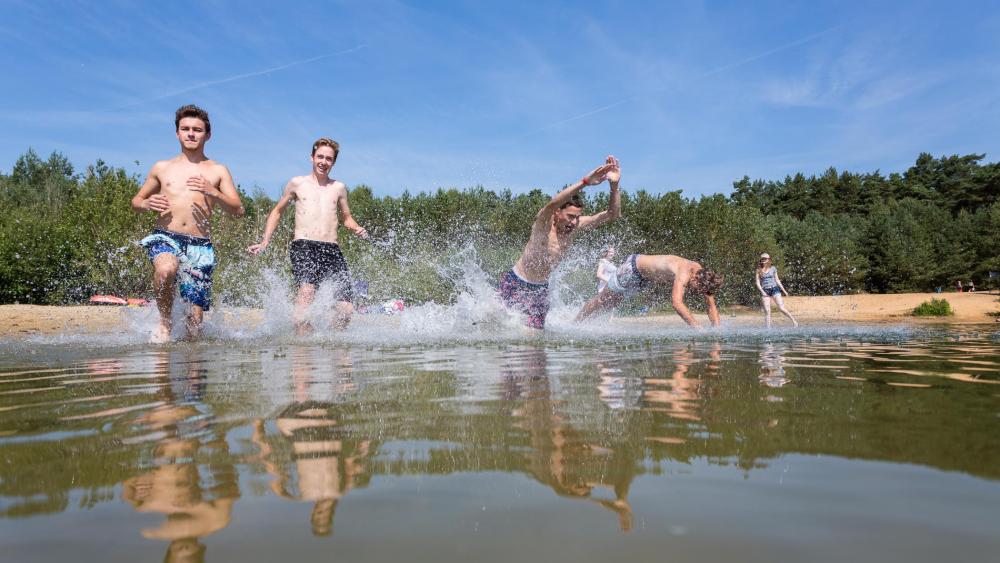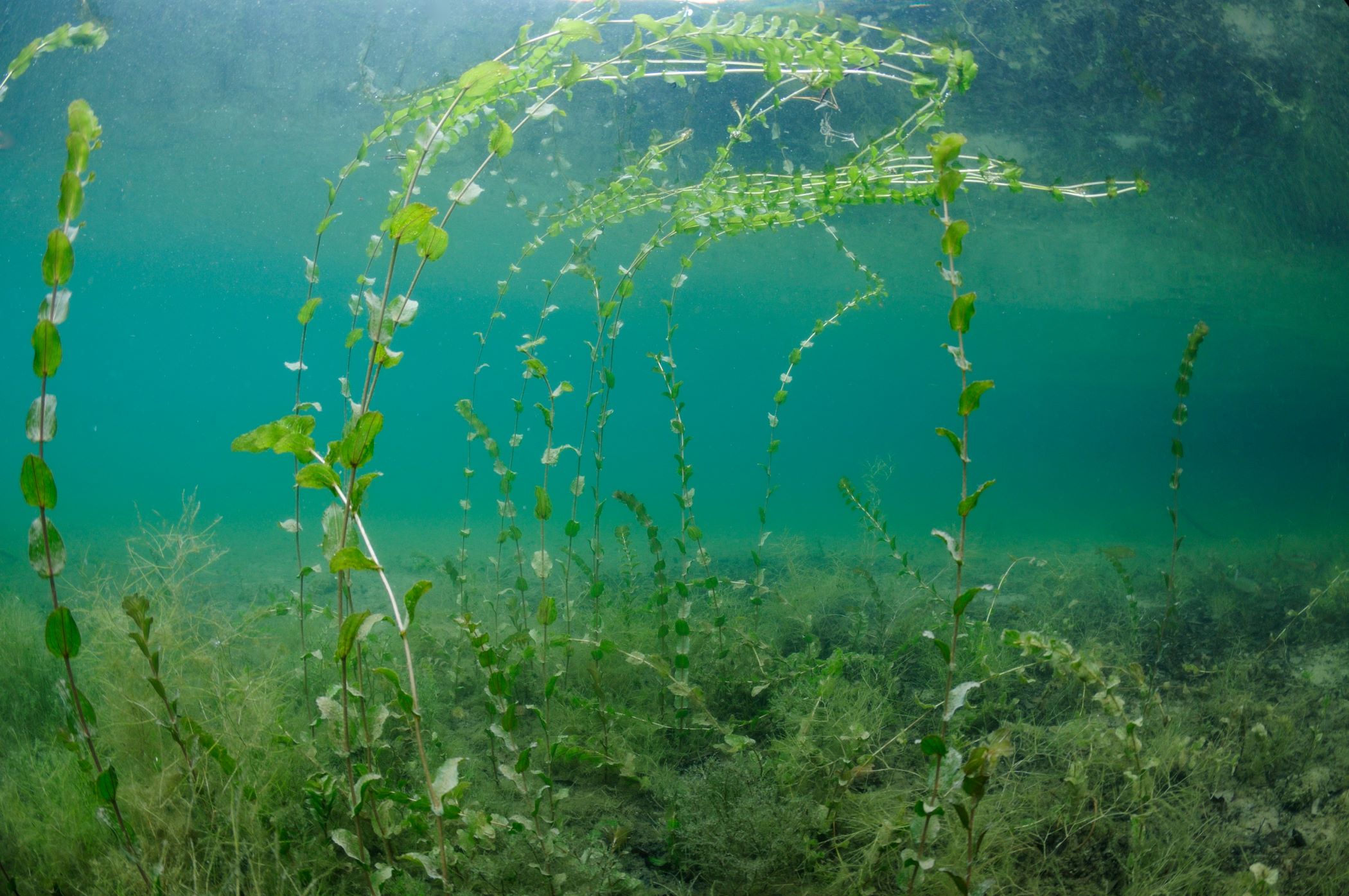
To the lake for a swim. | Photo: Florian Möller
The water is streaked with tiny green dots or stripes, which can also have a bluish tinge

Cyanobacteria | Photo: Nadja Neumann
These are probably cyanobacteria, commonly known as blue-green algae. They used to be classified as algae because they can photosynthesise. But unlike real algae, they have no nucleus - and are now classified as bacteria. The problem with cyanobacteria is that they can produce toxins that are harmful to animals and humans. But only when ingested in large quantities. To prevent health risks, bathing sites are regularly checked by the authorities for cyanobacteria and their toxins. In case of a contamination, bathing sites will be closed. As a rule of thumb, if you go in up to your knees, you should still be able to see your feet. If the water is too green, it is better to swim elsewhere.
Cloudy threads of algae on the shore and in the water

Filamentous algae | Photo: Sabine Hilt
These are probably filamentous algae. Filamentous algae are not a single species; many different species are grouped under this term because of their appearance. Mass accumulations of filamentous algae can threaten lake benthic communities and alter food webs, but researchers do not yet know the multiple impacts. For recreational users, benthic filamentous algae proliferations are not only unsightly – toxins from cyanobacteria can also accumulate in them. Dogs may be attracted by the fishy smell of the algae and run the risk of ingesting the toxins of the cyanobacteria. So, don't panic if you see small clouds of algae, but don't let your dog sniff the algae carpet on the shore, and keep away from children who swallow water when they swim.
Can you get stuck on water plants?

Water milfoil and perfoliate pondweed | Photo: Michael Feierabend
Aquatic plants, also known as macrophytes, can either float in the water or take root at the bottom. Even if they grow in the depths, most of them move towards the surface - towards the sunlight they need for photosynthesis. Aquatic plants can interfere with bathing or be frightening to some people. However, most aquatic plants, such as stonewort, can be easily stripped or pulled off. Large areas of water lilies should always be avoided by swimmers. Also for conservation reasons. The real danger is not the plants, but the panic they cause. So stay calm and swim out of the water lilies in the same way you swam in. Water plants are actually very useful. They help clean the water and provide food and shelter for many animals.
Ouch, I cut my foot!

Quagga mussels | Photo: Solvin Zankl
It must have been a mussel. In fact, more and more mussels have been found in our waters in recent years. The quagga mussel, in particular, is an invasive species that is spreading in large numbers in our lakes. It owes its unusual name to its light and dark striped shell, which resembles the fur pattern of the zebra species "quagga". There are both advantages and disadvantages to the introduction of this mussel. Mussels are filter feeders and remove nutrients from the water. One mussel can filter up to four litres of water a day, improving water quality. However, quagga mussels overgrow other mussels and molluscs with their byssus threads, restricting their movement and preventing them from closing their shells, for example.
These fish have the courage to come very close to me

European perch | Photo: Solvin Zankl
Most fish are shy. But there are also species that stay in shallow water and even go where there are lots of swimmers. These are European perch, for example. They are easy to spot with their black stripes and reddish fins. Other species such as common roach and common rudd, which also have reddish fins and silver-grey scales, come quite close to our feet. In larger lakes you can also see ukeleis, which feed on insects at the surface. The famous wels catfish, on the other hand, is rarely seen where there are many swimmers. It tends to stay at the bottom of the water and is not as biting and dangerous as is often claimed. However, global warming will shift the location of many fish species - cold-loving species will tend to move to deeper layers of water.
Dragonflies, water striders and co

Mosquito larvae | Photo: Solvin Zankl
Did you know that about 6% of all insects spend at least one stage of their life in water? Some flying insects, such as mayflies, stoneflies, caddisflies, dragonflies and mosquitos live in water as larvae. Deterioration in water quality can therefore affect the occurrence of these species. Mayflies can spend more than a year in the water before coming ashore for a few days to mate. The water strider, on the other hand, always lives on the border between water and air. The hairs on their legs allow them to move quickly on the surface of the water using surface tension without sinking. If you are very lucky, you may see a diving bell spider while snorkelling. It is the only species of spider that lives underwater rather than on land. It collects air in a dense underwater web – like a diving bell. The water spider is highly endangered because it needs very clean water to survive.
Beaver or muskrat?

Beaver. | Photo: Shutterstock
There's something with brown fur swimming in the water, and it's not a dog. It's probably a beaver, isn't it? It could also be a muskrat or a nutria. The muskrat stays much smaller than the beaver, the nutria can grow to almost the same size. During the day you are more likely to see them by the water than a beaver, which is crepuscular. The most obvious difference is the tail: the beaver can be easily identified by its flat, dark tail. The muskrat's is oval and the nutria's is round. Another important difference is that only the beaver's head is above water when it swims, whereas half the body of the muskrat or nutria is above water. Nutria also have ears that stand out clearly from their fur and white whiskers. Whatever the animal, they are not dangerous to humans - as long as you leave them alone. If you get too close they will defend themselves and beavers in particular are very territorial. So keep your distance. Incidentally, it is only in the last few years that large numbers of beavers have returned to Germany after almost becoming extinct. Their return is both celebrated and feared: As "landscape architects", they create floodplains and valuable habitats for animal and plant species. But its activities can also affect agriculture, fish farming and forestry, transport routes and water engineering structures.
Please spare the reeds!

Reed. | Photo: David Ausserhofer/IGB
Please keep your distance from the reed, especially when boating, as it is already suffering enough. Reeds are dying in many European lakes. There are many reasons for this: mechanical stress caused by the impact of waves from shipping, shoreline obstruction, animal predation, hikers or bathers. An IGB research team recently discovered that sulphate from mining may also be responsible for the decline of reeds in (Berlin) lakes. Reeds are important in many ways: as a habitat, they provide breeding sites and shelter for water birds, fish and insects. An intact reed belt reduces the impact of waves caused by boat traffic or strong winds. It strengthens the shore and prevents severe erosion. At the same time, reeds support the self-purification of water bodies by removing excess nutrients. As a measure against reed dieback, fascines, which look like simple wooden fences, are erected around the shores of many lakes to protect the reeds from the impact of waves.
So, that was just a glimpse. There is much more to discover. For more exciting facts about freshwaters, check out the Did you know? section of our website. Or in our IGB Newsletter.
Contributions to the topics on our website:
Mayflies, dragonflies & Co live as larvae in water
Ecological improvement of freshwater ecosystems benefits fish and people







